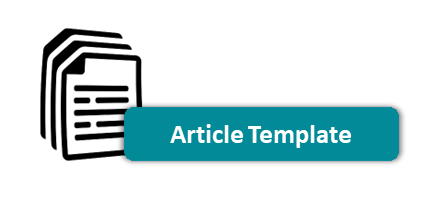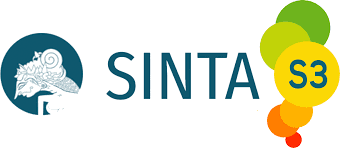PERSEPSI DAN PERSONALITAS APLIKASI SISTEM TEKNOLOGI INFORMASI NIR-KERTAS
DOI:
https://doi.org/10.24002/modus.v30i2.1707Abstract
Sistem teknologi informasi nir-kertas (paperless office) sudah mulai banyak digunakan di organisasi bisnis maupun nirlaba. Universitas juga sudah mulai menggunakan sistem teknologi informasi nir-kertas misalnya untuk pengisian nilai ujian mahasiswa langsung ke portal, pengiriman undangan rapat lewat e-mail dan lainnya. Penelitian ini mempunyai tujuan menguji dan membandingkan pengaruh persepsi dan personalitas dalam kaitannya dengan menggunakan teknologi nirkertas. Penelitian ini menggunakan model TAM dan TPB yang ditambahkan dengan variabel-variabel personalitas. Hipotesis-hipotesis diuji dengan menggunakan Partial Least Square. Penelitian ini menemukan hasil yang penting, yaitu tiga variabel personalitas signifikan mempenaruhi niat perilaku menggunakan sistem teknologi nir-kertas.Tiga dari lima variabel personalitas yang digunakan signifikan dan terdukung, yaitu variabel kesetujuan (agreeableness) dan kesupelan (extraversion) yang berhubungan positif dan signifikan mempengaruhi niat perilaku (intention), serta variabel kelambanan (neuroticism) yang berhubungan negatif dan signifikan mempengaruhi niat perilaku (intention).
Kata kunci: teknologi nir-kertas, kegunaan persepsian, kemudahan penggunaan persepsian, niat perilaku, perilaku, kontrolabitas, keyakinan-sendiri, kesetujuan, kesungguhan, kesupelan, kelambanan, keterbukaan terhadap pengalaman.
References
Abdillah, Willy. (2009). The Situational Cognitive Mediation Effects on Dispositional Personality Influence on the Intention to Use the Internet: An Empirical Study of Information Technology Acceptance Within Higher Education Institution, International Journal of Management in Education, 3 (3): 359-374.
Adams, D. A., R.R. Nelson, R.R. dan Todd, P.A. (1992). Perceived Usefulness, Ease of Use, and Usage of Information Technology: A Replication, MIS Quarterly, 16 (2): 227-247.
Agarwal, R., dan Prasad, J. (1998). A Conceptual and Operational Definition of Personal Innovativeness in the Domain of Information Technology, Information Systems Research 9 (2): 204-215.
Ajzen, I. (2002). Perceived Behavioral Control, Self-Efficacy, Locus of Control, and the Theory of Planned Behavior, Journal of Applied Social Psychology, 32: 665 – 683.
Amiel, T., and Sargent, S. L. (2004). Individual Differences in Internet Usage Motives, Computers in Human Behavior 20 (6): 711-726.
Bandura, A. (1986). Social Foundations of Thought and Action: A Social Cognitive Theory, Prentice Hall, Englewood Cliffs, NJ.
Chau, P.Y.K. (1996). An Empirical Assessment of a Modified Technology Acceptance Model, Journal of Management Information Systems, 13 (2): 185-204.
Compeau, D., Higgins, C., and Huff, S. (1999). Social Cognitive Theory and Individual Reactions to Computing Technology: A Longitudinal Study, MIS Quarterly, 23 (2): 145-158.
Davis, F.D., Bagozzi, R.P., dan Warshaw, P.R. (1989). User Acceptance of Computer Technology: A Comparison of Two Theoretical Models, Management Science, 35 (8): 982-1003.
Doll, W. J., Hendrickson, A., dan Deng, X. (1998). Using Davis’s Perceived Usefulness and Ease-of-Use Instruments For Decision Making: A Confirmatory and Multigroup Invariance Analysis, Decision Sciences, 29 (4): 839-869.
Gist, M,E., Schwoerer, C.E., dan Rosen, B. (1989). Effects of Alternative Training Methods on Self-efficacy and Performance in Computer Software Training, Journal of Applied Psychology, 74 (6): 884-891.
Hamburger, Y. A., and Ben-Artizi, E. (2000). The Relationship Between Extraversion and Neuroticism and the Different Uses of the Internet, Computers in Human Behavior, 16 (4): 441-449.
Hartono, J. (2007). Sistem Informasi Keperilakuan, Andi Offset, Yogyakarta.
Hartwick, J. dan Barki, H. (1994). Explaining the Role of User Participation in Information System Use, Management Science, 40 (4): 440-465.
Hendrickson, A.R., Massey, P.D., dan Cronan, T.P. (1993). On the Test-retest Reliability of Perceived Usefulness and Perceived Ease of Use Scales, MIS Quarterly, 17 (2): 227-230.
Hill, T., Smith, N.D., dan Mann, M.F. (1987). Role of Efficacy Expectations in Predicting the Decision to Use Advanced Technologies: the Case of Computers, Journal of Applied Psychology, 72 (2): 307-313.
Hsu, M. H. and Chiu, C. M. (2004). Predicting Electronic Service Continuance with a Decomposed Theory of Planned Behaviour, Behaviour & Information Technology, 23 (5): 359–373.
Igbaria, M., Iivari, J. and Maragahh, H. (1995). Why do Individuals Use Computer Technology? Information and Management, 29: 227 – 238.
Lai, PC. (2017). The Literature Review of Technology Adoption Models and Theories for The Novelty Technology, Journal of Information Systems and Technology Management, 14 (1): 21-38.
Landers, R. N. and Lounsbury, J. W. (2006). An Investigation of Big Five and Narrow Personality Traits in Relation to Internet Usage, Computers in Human Behavior, 22 (2): 283-293.
Lou, H., W. Luo, dan Strong, D. (2000). Perceived Critical Mass Effect on Groupware Acceptance, European Journal of Information Systems, 9 (2): 91-103.
Lucas, H. C., Jr. (1973). Computer Based Information Systems in Organizations, Science Research Associates, Inc., Chicago, IL.
Maddi, S. R. (1989). Personality Theories: A Comparative Analysis (5th ed.), Dorsey, Homewood, IL.
Malhotra, Y., dan Galletta, D.F. (1999). Extending the Technology Acceptance Model to Account for Social Influence Theoretical Bases and Empirical Validation, Proceedings of the 32nd Hawaii International Conference on System Sciences.
Mathieson, K. (1991). Predicting User Intentions: Comparing the Technology Acceptance Model With the Theory of Planned Behavior, Information Systems Research, 2 (3): 173-191.
McElroy, J.C., Hendrickson, A. R., Townsend, A. M., dan De Marie, S. M. (2007). Dispositional Factors In Internet Use: Personality Versus Cognitive Style, MIS Quarterly, 31 (4): 809-820.
Povey, R., Conner, M., Sparks, P., James, R. and Shepher, R. (2000). Application of the Theory of Planned Behaviour to Two Dietary Behaviours: Roles of Perceived Control and Self-Efficacy, British Journal of Health Psychology, 5: 121 – 139.
Schell, K. L. (2002). Psychological Assessment, Resources Inc, Revised.
Sun, H., & Zhang, P. (2003). A New Perspective to Analyze User Technology Acceptance, Working Paper, Syracuse University.
Surendran, Priyanka. (2012). Technology Acceptance Model: A Survey of Literature. International Journal of Business and Social Research, 2 (4): 175-178.
Swickert, R. J., Hittner, J. B., Harris, J. L., and Herring, J. A. (2002). Relationship Between Internet Use, Personality and Social Support, Computers in Human Behavior, 18 (4): 437-451.
Szajna, B. (1994). Software Evaluation and Choice Predictive Validation of the Technology Acceptance Instrument, MIS Quarterly, 18 (3): 319-324.
Taylor, S., dan Todd, P. A. (1995). Understanding Information Technology Usage: A Test of Competing Models, Information Systems Research, 6 (2): 144-176.
Thompson, R.L., Higgins, C.A., dan Howell, J.M. (1991). Personal Computing Toward a Conceptual Model of Utilization, MIS Quarterly, 15 (1): 125-143.
Tuten, T., and Bosnjak, M. (2001). Understanding Differences in Web Usage: The Role of Need for Cognition and the Five Factor Model of Personality, Social Behavior and Personality, 29 (4): 391-398.
Van der Heijden, H. (2000). Using the Technology Acceptance Model to Predict Website Usage: Extensions and Empirical Test, Series Research Memoranda.
Venkatesh, V., dan Davis, F.D. (1996). A Model of the Antecedents of Perceived Ease of Use Development and Test, Decision Sciences, 27 (3): 451-481.
Zmud, R. W. (1979). Individual Differences and MIS Success: A Review of the Empirical Literature, Management Science, 25 (10): 966-97.














